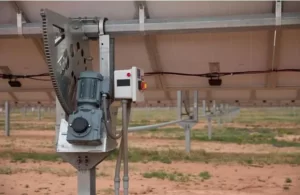Solar panel manufacturers are constantly making incremental improvements to their solar panels, creating higher unit electricity production than previous solar panel components. Another effective way to increase system output is to use a solar tracker, which, unlike a fixed inclined ground installation system, allows the solar panels to follow the path of the sun throughout the day.
There are two main types of solar trackers on the market: single axis and dual axis. A single axis sun tracker tracks the sun from east to west, rotating at a point and moving synchronously by solar panels or parts. The dual axis tracker rotates on the X and Y axes, allowing the panel to directly track the sun.

Single axis tracker
Tracking technology is not new to the solar energy market, and single axis solutions have become the standard for large-scale utility applications. Compared to dual axis trackers, single axis trackers collect less energy per unit, but have shorter shelf heights and require less installation space, creating a more concentrated system footprint and easier to operate and maintain components.
Single axis trackers are divided into centralized and decentralized tracker types. Centralized or distributed trackers use a single motor to power the transmission system between rows, which will move the entire panel section. The decentralized system has one motor per tracking line. There are also instances of trackers with motors on each group of shelves, making them more adjustable during installation and in some cases allowing them to be tracked independently of adjacent components.
Dual axis tracker
Due to the fact that the rotation of the Earth relative to the Sun is not the same throughout the year, and the arc changes with the seasons, a dual axis tracking system will always achieve higher energy output than a single axis system because it can move directly along that path. A dual axis solar tracker generates 30% to 45% more energy than a fixed tilt solar system.
Dual axis trackers are more commonly used in residential and small commercial applications, and there are also deployments on a public utility scale. Each of these trackers is installed at the top of an elevated column to consider the larger angle range that the installed panel will reach. The dual axis tracker can accommodate up to 20 solar panels per unit.
At high altitudes, solar panels are difficult to clean. However, as the top space increases, the dual axis tracker can keep the ground below for other purposes, such as agriculture or even car sheds.
This is a largely undeveloped niche market, but rooftop tracking solutions are also beginning to emerge. These roof trackers operate a bit like dual axis trackers, rotating on a carousel like track at the bottom of their shelves and adjusting the panel angle to track the sun more accurately than single axis trackers.
If you want to know more about solar panels, please contact us, the solar panel manufacturer – Huanqi Technology (Shenzhen) Co., Ltd.




